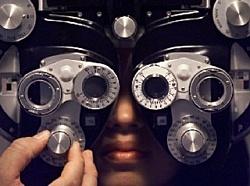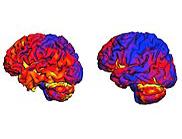ALZHEIMER: UN ESAME DELLA VISTA
PER UNA DIAGNOSI PRECOCE
Dall'Australia una ricerca per la diagnosi precoce dell'Alzheimer
Presto con un semplice test all'occhio si potra' essere in grado di individuare i segni precoci dell'Alzheimer. | Un gruppo di ricercatori della Commonwealth Scientific and Industrial Research Organisation dell'Australia e' convinto di aver individuato le differenze che possono permettere di distinguere nella retina dei malati i segni della demenza, favorendo cosi' la diagnosi precoce della malattia degenerativa. Questo rappresenta un importante passo in avanti nella gestione dei pazienti con l'Alzheimer, secondo quanto emerso in occasione dell'American Alzheimer's Association International Conference che si e' tenuta a Parigi. | "Questo studio – ha commentato Rebecca Wood, amministratore delegato dell'Alzheimer's Research del Regno Unito – si aggiunge ai lavori precedenti suggerendo che la scansione degli occhi potrebbe essere un valido aiuto per la diagnosi dell'Alzheimer. I risultati potrebbero portare a un metodo semplice ed efficare per l'individuazione della demenza nella sue prime fasi". Gli scienziati australiani hanno coinvolto nello studio 126 persone, la cui retina e' stata analizzata dettagliatamente. Ebbene, i ricercatori hanno scoperto che la larghezza dei vasi sanguigni era "significativamente diversa" tra quelli con la malattia di Alzheimer rispetto alle persone sane .
Per ulteriori dettagli:
http://www.agi.it/salute/notizie/201107181255-hpg-rsa1009-alzheimer_un_esame_della_vista_per_una_diagnosi_precoce

Alzheimer's Disease: image processing for early diagnosis
Effective treatment for Alzheimer’s Disease is expected to be aided by earlier detection and diagnosis using CSIRO’s brain image processing software. | Computerised enhancement and analysis of three-dimensional Positron Emission Tomography (PET) and Magnetic Resonance Imaging (MRI) brain images is showing promise as an early diagnostic tool. | The technique gives clinicians a powerful new procedure with improved reliability and accuracy for detecting the early stages of Alzheimer's Disease, compared with manual image analysis. | Success in the project will help ensure that people with early signs of Alzheimer's Disease can receive suitable care and therapeutic treatments, or even make lifestyle changes, all aimed at slowing or preventing development of the disease. | CSIRO's image processing tools will be useful for tracking the effectiveness of new therapies, as well as for selecting those who need them.

Preventative Health National Research Flagship Study of Ageing
The Alzheimer's Disease research by CSIRO's Biomedical Imaging research team collaborates with the Flagship Collaboration Cluster Australian Imaging, Biomarker and Lifestyle (AIBL) Study. AIBL was initiated by the CSIRO Preventative Health National Research Flagship. | AIBL is a joint activity between the: University of Melbourne | Edith Cowan University, Western Australia | Neurosciences Australia | Mental Health Research Institute of Victoria | National Ageing Research Institute | Preventative Health Flagship. | The Biomedical Imaging Team from the Australian eHealth Research Centre is collaborating with the AIBL Study by developing image analysis methods to quantify disease progression with Magnetic Resonance and Positron Emission Tomography images. The Team's leader is Dr Olivier Salvado. | The CSIRO team's new 3D imaging capabilities have enabled accurate mapping of the disease progress in its early stages.By bringing together researchers from around Australia, AIBL aims to improve our understanding of the causes and diagnosis of Alzheimer's Disease by examining lifestyle and dietary factors that may influence its onset, and help develop preventative strategies. | AIBL's 1 000 volunteer subjects are over the age of 60 and their condition is being followed over 18 months. | Information from psychological assessments and testing for blood biomarkers is being combined with PET and MRI image analysis.
Imaging agent
AIBL is the largest study in the world in which PET scans are being used with a new imaging agent known as Pittsburgh Compound-B. | This agent acts in a similar way to a dye, revealing the build-up of amyloid deposits in the brain. These amyloid deposits are believed to cause the disease. | The CSIRO team's new 3D imaging capabilities have enabled accurate mapping of disease progress in its early stages. MRI imaging reveals brain shrinkage, while the PET scans with the imaging agent track the build-up of amyloid deposits. | As they become available and are regularly updated, the software tools developed by the Biomedical Imaging team are being evaluated by research partners in the AIBL program, and by collaborators in other countries.

Progress and goals
So far, several imaging markers have been found to accurately identify patients with Alzheimer's, but much more information will be available as follow-up data become available and new algorithms can be validated. | The current goals of the team are to merge information from multiple imaging modalities and perform advanced statistical analysis of the population, in addition to measuring precise changes in the brain structures, functions, and composition. | This project is part of CSIRO's Preventive Health National Research Flagship. | The project is being carried out by the Australian e-Health Research Centre, a partnership between CSIRO and the State of Queensland.
Images:
Typical brain images of 70 year-old subjects: a healthy subject (left) and a patient with Alzheimer's. The colour codes the thickness of the cortex (the more blue, the thinner). | Yeast species like these could be used to develop a rapid screening process for identifying compounds which inhibit Alzheimer's disease.
More info at > http://www.csiro.au/science/Alzheimers.html





